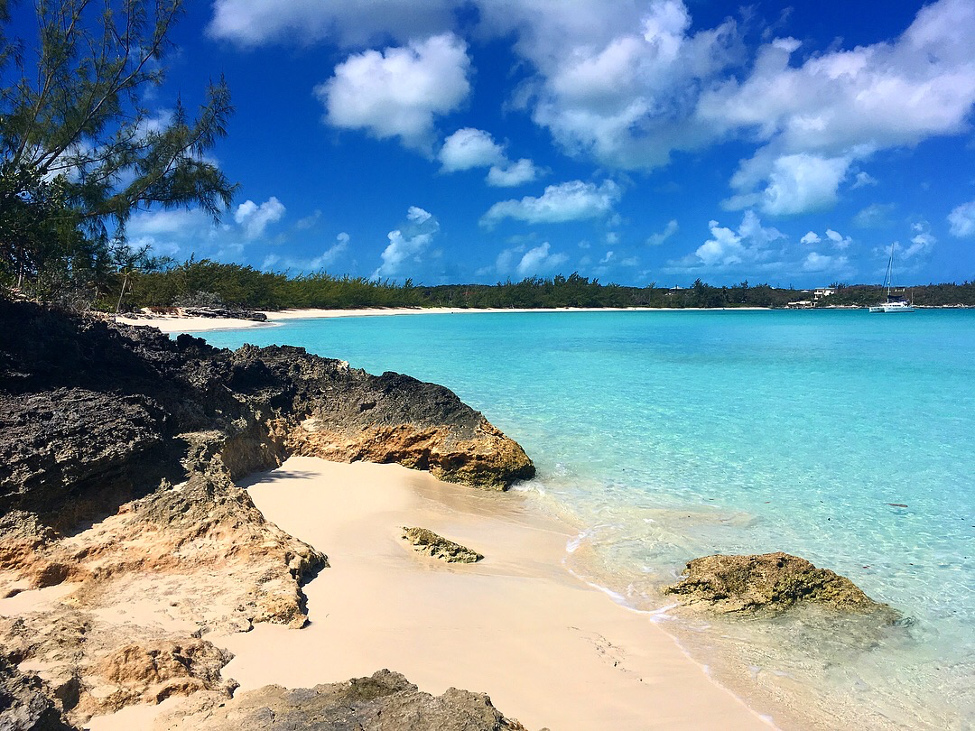 Earth & Space
Earth & Space
What Caribbean coasts can tell us about the future of climate change
Today’s global warming is threatening our planet, but similar events also happened in the past. This study reveals that characteristic Caribbean coastal dunes were shaped by a dry and windy climate caused by ancient global warming. This discovery will help better predict the future outcomes of today’s climate changes.

Today's climate change is driving geological changes such as coastal erosion and expansion of arid areas. It is also threatening our planet. Such dramatic climate changes happened before in the planet's history. These past events may teach us to forecast what the ongoing events are going to bring.
Remnants of the past climate events form the "geological archives" of our planet. Remarkable remnants include well-preserved chevron dunes lying on the Bahamian coasts. The term chevron is used to describe the characteristic large U-shape dunes, which were formed during the last interglacial period about 120,000 years ago. This geological era attracts scientists' attention because of the extraordinary global warming to the extent of 1.5°C above today's average global temperature. In other words, understanding what happened in that period would give us hints to forecasting possible future consequences of today's global warming and help us prepare better to face them.
What shaped these unique dunes 120,000 years ago? We know that they were formed as a consequence of characteristic climate-change-driven events during an era of an extreme climate. However, these critical events remain debated with scientists proposing two possible scenarios: storm-driven gigantic waves or severe winds associated with aridification.
Supporting the first, "gigantic wave" hypothesis, the past global warming likely caused a collapse of the East and West Antarctic ice sheets resulting in a cooler high latitude ocean. Such ocean alteration potentially drove strong North Atlantic storms. The massive storms could generate giant waves, which eventually shaped chevron dunes when they washed over the shoreline.
According to the second, "severe wind" hypothesis, the chevrons were shaped by strong winds and thus can be categorised into U-shape parabolic dunes. This hypothesis, however, has failed to explain why the chevron formation was constrained to the last interglacial period in the Bahamas and whether it was associated with past global warming.
In this research, we aimed to obtain the missing piece of information and figure out which hypothesis is more likely to explain how the Bahamian chevrons were formed. To do so, we compared the chevrons with two different structures: sediments deposited by waves and parabolic dunes formed by winds. We found that chevrons and parabolic dunes are structurally very similar. For example, the chevrons' architecture included characteristic wind-related sediment layers called foresets. Furthermore, we observed some distinct layers of sediment left by wind ripples, called climbing translatent strata. Collectively, these findings suggest that the chevrons were most likely shaped by wind and not by waves.
Combining all the data obtained previously and in this study, chevrons appear to be large parabolic dunes made of limestones shaped by strong winds. We are now able to pinpoint the climate conditions that drove the formation of chevrons as a consequence of global warming during the last interglacial period — Firstly, a high sea flooded the Bahamas Islands and boosted the sediment production; Secondly, drier and windier climate than today enhanced a wind-driven transport of sediment; and thirdly, shrubbier and grassier vegetation facilitated a sediment transport by wind.
This study successfully linked climate conditions with atmospheric circulation from past events, allowing us to explain how an ancient drastic global warming drove the characteristic dune formation in the Bahamas. It has enabled us to understand how certain climate changes can influence atmospheric circulation that controls coastal desertification. Learning such past climate events will help forecast possible future outcomes of ongoing global warming and better prepare for the impending crisis.
Original Article:
Vimpere, L., Piero, D., Shawwa, N., Beguelin, K. & Kindler, P. Upper Pleistocene parabolic ridges (i.e. 'chevrons') from the Bahamas: Storm-wave sediments or aeolian deposits? A quantitative approach. Sedimentology. doi:10.1111/sed.12828.
Edited by:
Dr. Akira Ohkubo , Associate Editor
We thought you might like
Ocean acidification and its effects on coral reef growth
Jul 8, 2016 in Earth & Space | 3.5 min read by Rebecca AlbrightResetting nature’s clock: shifting seasons and species relationships
Sep 14, 2016 in Earth & Space | 3.5 min read by Stephen Thackeray , Sarah BurtheThe silent battle of young corals against ocean acidification
Oct 19, 2016 in Earth & Space | 4 min read by Taryn FosterFor polar bears the cost of living is rising
Mar 13, 2018 in Earth & Space | 4 min read by George DurnerMore from Earth & Space
Discovery of the first radiation belt beyond the Solar System
Jan 27, 2025 in Earth & Space | 3.5 min read by Juan Bautista Climent OliverOne million (paper) satellites
Jan 24, 2025 in Earth & Space | 3 min read by Ewan Wright , Andrew FalleVolcanic Ash: A Nutrient Boost for Reef-Building Corals
Sep 18, 2024 in Earth & Space | 4 min read by Frank Förster , Tom SheldrakeAmmonia Energy: A Call for Environmental Awareness
Aug 29, 2024 in Earth & Space | 3.5 min read by Matteo Bertagni , Robert Socolow , Amilcare PorporatoLikely increase in coral thermal tolerance at a Pacific archipelago
Dec 29, 2023 in Earth & Space | 3 min read by Liam LachsEditor's picks
Trending now
Popular topics


